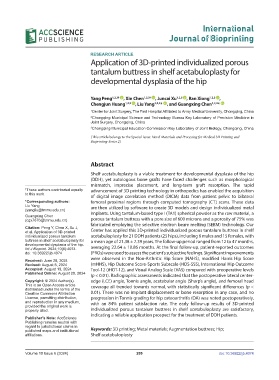Page 217 - IJB-10-6
P. 217
International
Journal of Bioprinting
RESEARCH ARTICLE
Application of 3D-printed individualized porous
tantalum buttress in shelf acetabuloplasty for
developmental dysplasia of the hip
Yang Peng 1,2,3† id , Xin Chen 1,2,3† id , Juncai Xu 1,2,3 id , Ran Xiong 1,2,3 id ,
Chengjun Huang 1,2,3 id , Liu Yang 1,2,3 * , and Guangxing Chen 1,2,3 * id
id
1 Center for Joint Surgery, The First Hospital Affiliated to Army Medical University, Chongqing, China
2 Chongqing Municipal Science and Technology Bureau Key Laboratory of Precision Medicine in
Joint Surgery, Chongqing, China
3 Chongqing Municipal Education Commission Key Laboratory of Joint Biology, Chongqing, China
(This article belongs to the Special Issue: Novel Materials and Processing for Medical 3D Printing and
Bioprinting-Series 2)
Abstract
Shelf acetabuloplasty is a viable treatment for developmental dysplasia of the hip
(DDH), yet autologous bone grafts have faced challenges such as morphological
mismatch, imprecise placement, and long-term graft resorption. The rapid
† These authors contributed equally advancement of 3D printing technology in orthopedics has enabled the acquisition
to this work.
of digital image correlation method (DICM) data from patient pelvic to bilateral
*Corresponding authors: femoral proximal regions through computed tomography (CT) scans. These data
Liu Yang are then utilized by software to create 3D models and design individualized metal
(yangliu@tmmu.edu.cn)
Guangxing Chen implants. Using tantalum-based type I (TA1) spherical powder as the raw material, a
(cgx7676@tmmu.edu.cn) porous tantalum buttress with a pore size of 600 microns and a porosity of 75% was
fabricated employing the selective electron beam melting (SEBM) technology. Our
Citation: Peng Y, Chen X, Xu J,
et al. Application of 3D-printed Center has applied this 3D-printed individualized porous tantalum buttress in shelf
individualized porous tantalum acetabuloplasty for 21 DDH patients (25 hips), including 6 males and 15 females, with
buttress in shelf acetabuloplasty for a mean age of 21.38 ± 7.39 years. The follow-up period ranged from 12 to 47 months,
developmental dysplasia of the hip.
Int J Bioprint. 2024;10(6):4074. averaging 22.64 ± 10.86 months. At the final follow-up, patient-reported outcomes
doi: 10.36922/ijb.4074 (PROs) were used to assess the patient’s subjective feelings. Significant improvements
were observed in the Non-Arthritic Hip Score (NAHS), modified Harris Hip Score
Received: June 28, 2024
Revised: August 8, 2024 (mHHS), Hip Outcome Score-Sports Subscale (HOS-SSS), International Hip Outcome
Accepted: August 19, 2024 Tool-12 (iHOT-12), and Visual Analog Scale (VAS) compared with preoperative levels
Published Online: August 20, 2024 (p < 0.01). Radiographic assessments indicated that the postoperative lateral center-
Copyright: © 2024 Author(s). edge (LCE) angle, Tonnis angle, acetabular angle (Sharp’s angle), and femoral head
This is an Open Access article coverage all trended towards normal, with statistically significant differences (p <
distributed under the terms of the
Creative Commons Attribution 0.01). There was no implant displacement or bone resorption in any case, and no
License, permitting distribution, progression in Tonnis grading for hip osteoarthritis (OA) was noted postoperatively,
and reproduction in any medium, with an 84% patient satisfaction rate. The early follow-up results of 3D-printed
provided the original work is
properly cited. individualized porous tantalum buttress in shelf acetabuloplasty are satisfactory,
indicating a reliable application prospect for the treatment of DDH patients.
Publisher’s Note: AccScience
Publishing remains neutral with
regard to jurisdictional claims in
published maps and institutional Keywords: 3D printing; Metal materials; Augmentation buttress; Hip;
affiliations. Shelf acetabuloplasty
Volume 10 Issue 6 (2024) 209 doi: 10.36922/ijb.4074

